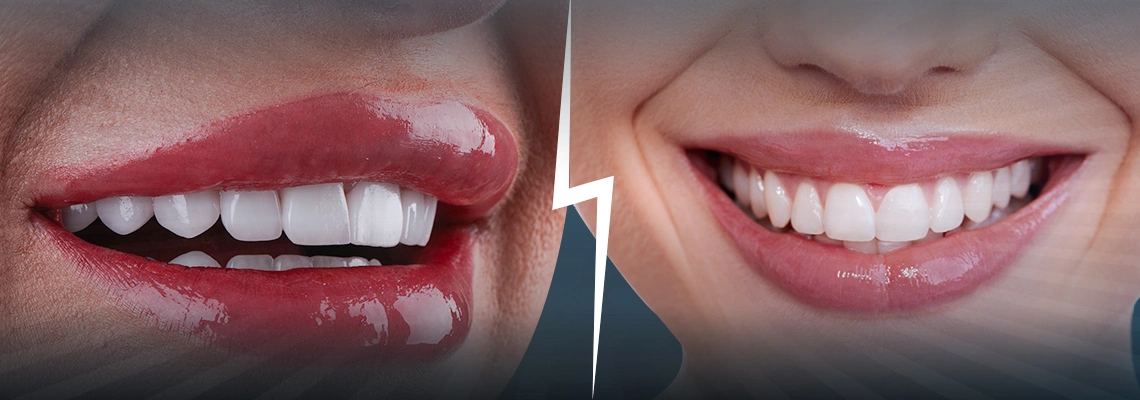Teeth discoloration or tooth stains is a common dental problem that affects the appearance and health of your teeth, what are its types and causes? How can they be treated and prevented? Well, that's what we're going to talk about in this article, please read on.
Table of contents:
Teeth discoloration definition
Teeth discoloration is a change in the natural color of your teeth. It can affect the entire tooth or only parts of it. Teeth discoloration can range from yellow to brown to gray to black, depending on the cause and severity. Teeth stains are surface marks or spots on your teeth that are usually caused by external factors, such as food, drinks, tobacco, or plaque. Teeth stains can also be intrinsic, meaning they are embedded in the tooth structure.
Related articles:
Types of discoloration of teeth
There are three main types of teeth discoloration: extrinsic, intrinsic, and age-related.
-
Extrinsic discoloration affects the outer layer of the tooth (enamel) and is caused by substances that come in contact with the tooth surface. Common causes of extrinsic discoloration include coffee, tea, wine, cola, berries, sauces, tobacco, and poor oral hygiene.
-
Intrinsic discoloration affects the inner layer of the tooth (dentin) and is caused by factors that alter the tooth structure from within. Common causes of intrinsic discoloration include certain medications (such as tetracycline antibiotics), excessive fluoride intake, dental trauma, tooth decay, root canal treatment, genetic disorders (such as dentinogenesis imperfecta), and infections during tooth development.
-
Age-related discoloration is a combination of both extrinsic and intrinsic factors. As you age, your enamel becomes thinner and more transparent, exposing the yellowish dentin underneath. Your dentin also becomes darker and more discolored over time due to wear and tear and accumulation of stains.
Teeth discoloration causes
Teeth discoloration or stains are changes in the color of your teeth that can have various causes, such as:
-
Food and drink: Dark or acidic items can stain your enamel.
-
Tobacco: Nicotine and tar can make your teeth yellow or brown.
-
Oral hygiene: Plaque and tartar can discolor your teeth and cause bacteria growth.
-
Medications: Some drugs can affect your teeth’s color by staining the enamel or altering the development of the teeth. Some examples are tetracycline antibiotics, antihistamines, antipsychotics, blood pressure drugs, and iron supplements.
-
Fluoride: Too much fluoride can cause white spots or streaks on your teeth.
-
Diseases: Some diseases or conditions can damage your enamel or dentin, leading to discoloration.
-
Trauma: Your tooth can darken or turn gray from injury or accident.
-
Aging: Your enamel can become thinner and more transparent, exposing the yellowish dentin.
-
Braces: It can be harder to clean your teeth with braces, leading to plaque buildup and stains.
-
Pregnancy: Your gums can become more inflamed and bleeding during pregnancy, which can affect your teeth’s health and appearance. Some supplements or medications taken during pregnancy can also cause tooth discoloration.
-
Vitamin deficiency: Vitamin deficiency can affect the health and appearance of your teeth. For example, vitamin C deficiency can cause scurvy, which can lead to bleeding gums, tooth loss, and discoloration.

Teeth discoloration treatment
Some methods to treat teeth discoloration or stains are:
-
Whitening products: Products with bleaching agents to remove stains and brighten teeth. They can be toothpastes, strips, gels, trays, or rinses. They work better for external stains than internal stains.
-
Professional whitening: A procedure by a dentist that uses stronger bleaching agents and light or heat to whiten teeth by several shades. It can last for months or years and can treat some internal stains, such as tetracycline or fluoride stains.
-
Veneers: Thin shells of porcelain or resin that are attached to the front of teeth to hide stains, chips, cracks, gaps, or misshapen teeth. They are custom-made and require some enamel removal.
-
Crowns: Caps that cover the whole tooth to restore its shape, size, strength, and appearance. They are usually metal, porcelain, or ceramic and require some enamel removal. They can treat severe decay, damage, or discoloration.
-
Bonding: A technique that uses resin material to fix or improve the appearance of teeth. It can fill cavities, fix chips or cracks, close gaps, or cover stains. It is simple and cheap.
-
Root canal treatment: A procedure that removes the infected or dead pulp from inside the tooth and seals it with a filling or a crown. It can save the tooth and prevent further infection and discoloration.
How to remove brown stains from teeth naturally
Some natural ways to remove mild to moderate brown stains from your teeth are:
-
Baking soda: A mild abrasive that can scrub away stains and prevent bacteria growth. Mix it with water to make a paste and brush your teeth once or twice a week. You can also add lemon juice or hydrogen peroxide for extra whitening, but not too often as they can damage your enamel.
-
Oil pulling: An ancient practice that involves swishing coconut oil in your mouth for 15 to 20 minutes to remove bacteria, toxins, plaque, and stains. Do it every morning before brushing your teeth and rinse your mouth with water.
-
Apple cider vinegar: A natural acid that can dissolve plaque and stains and prevent infections and bad breath. Dilute it with water and gargle with it for a few minutes before brushing your teeth. Do this once or twice a week. Do not use undiluted vinegar as it can erode your enamel and cause sensitivity.
-
Fruits: Some fruits contain enzymes or acids that can break down stains and plaque and prevent tooth decay. Examples are strawberries and pineapples. Mash them and rub them on your teeth for a few minutes before rinsing your mouth with water. You can also eat them regularly as part of a healthy diet.
Teeth stain prevention
The best way to prevent teeth stains is to avoid the factors that cause them in the first place. Some of the tips to prevent teeth stains include:
-
Brushing your teeth at least twice a day with fluoride toothpaste
-
Flossing between your teeth daily
-
Rinsing with an antiseptic mouthwash
-
Visiting your dentist regularly for check-ups and cleanings
-
Avoiding or limiting foods and drinks that stain your teeth, such as coffee, tea, wine, cola, berries, sauces
-
Quitting smoking or chewing tobacco
-
Rinse your mouth with water after drinking any dark-colored liquids

Sources:
- Teeth discoloration causes
- https://www.webmd.com/oral-health/tooth-discoloration
- What can cause teeth discoloration and stains
- https://www.healthline.com/health/tooth-discoloration















